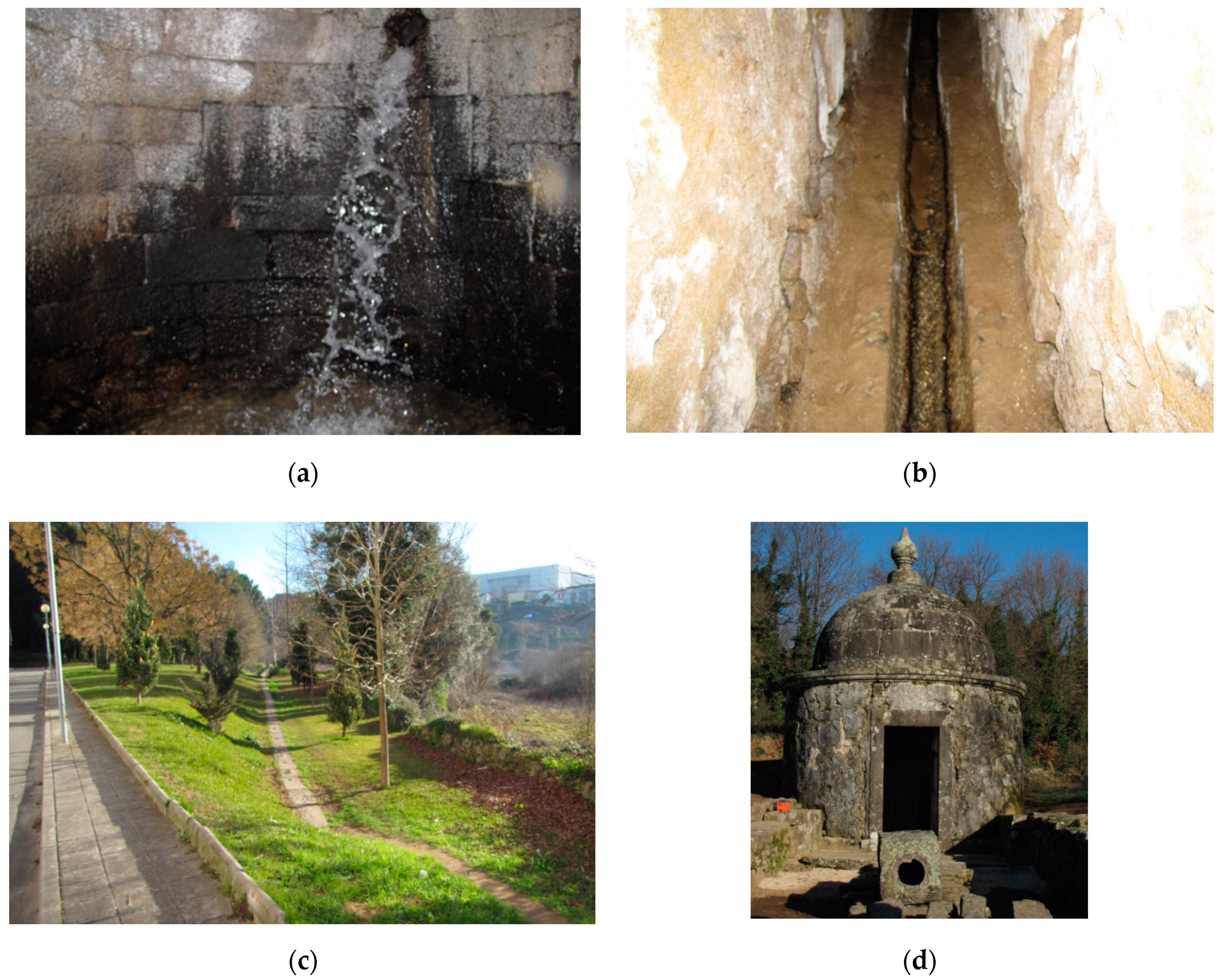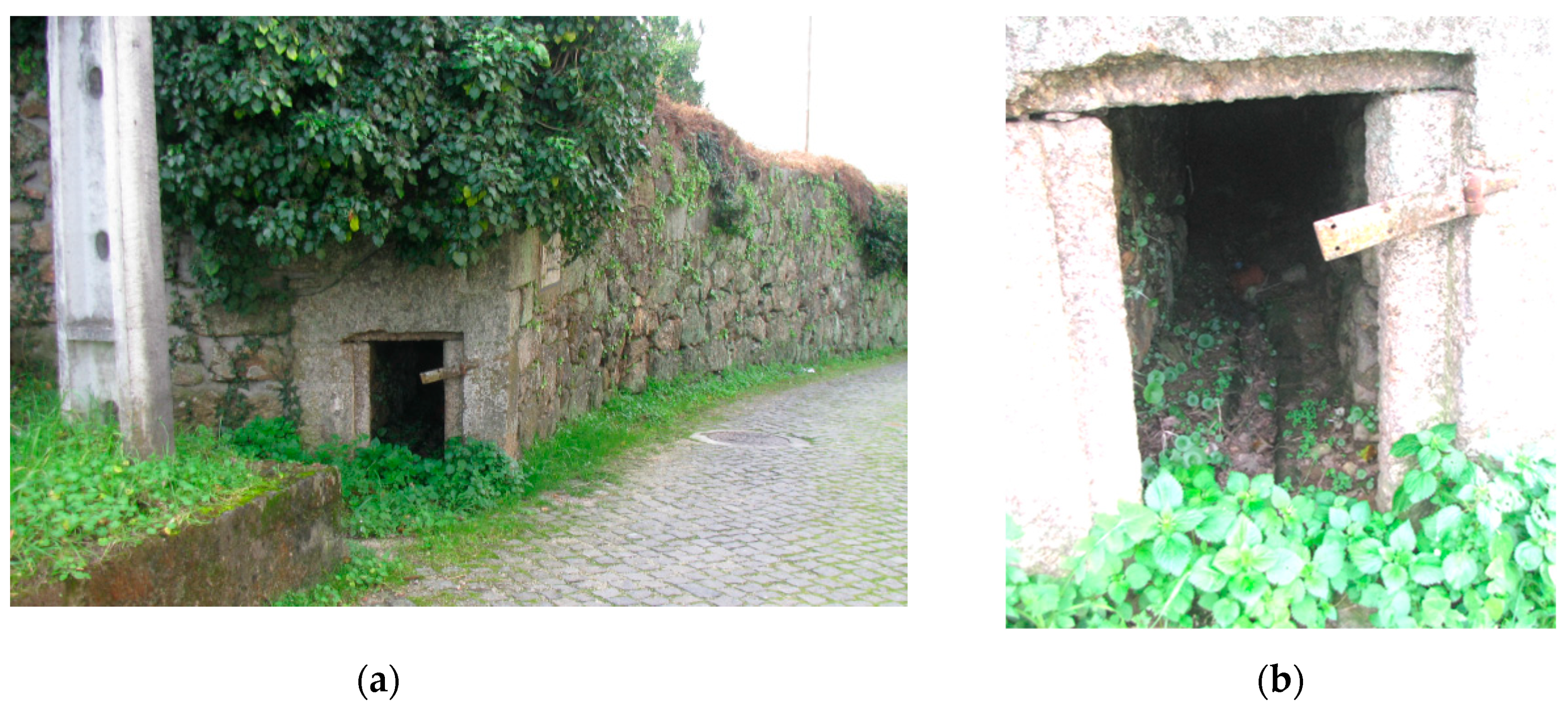Geological Materials as Cultural Markers of Water Resources †
Abstract
:1. Introduction
2. Discussion
3. Final Considerations
Author Contributions
Funding
Institutional Review Board Statement
Informed Consent Statement
Data Availability Statement
Acknowledgments
Conflicts of Interest
References
- Jorgensen, D.G.; Yasin al-Tikiriti, W. A hydrologic and archeologic study of climate change in Al Ain, United Arab Emirates. Glob. Planet. Chang. 2003, 35, 37–49. [Google Scholar] [CrossRef]
- Birgin Iritas, S.; Ali Turksoy, V.; Deniz, S.; Kocoglu, S.; Kirat, G.; Can Demirkesen, A.; Baba, A. A quality assessment of public water fountains and relation to human health: A case study from Yozgat, Turkey. Water Environ. J. 2019, 33, 518–535. [Google Scholar] [CrossRef]
- Juuti, P.; Antoniou, G.; Dragoni, W.; El-Gohary, F.; De Feo, G.; Katko, T.; Rajala, R.; Zheng, X.; Drusiani, R.; Angelakis, A. Short Global History of Fountains. Water 2015, 7, 2314–2348. [Google Scholar] [CrossRef]
- Available online: https://www.washingtonpost.com/opinions/we-dont-trust-drinking-fountains-anymore-and-thats-bad-for-our-health/2015/07/02/24eca9bc-15f0-11e5-9ddc-e3353542100c_story.html (accessed on 21 November 2020).
- Hein, C. Adaptive Strategies for Water Heritage: Past, Present and Future; Springer Nature: Berlin/Heidelberg, Germany, 2020; ISBN 978-3-030-00268-8. [Google Scholar]
- Martins, M.; Meireles, J.; Ribeiro, M.D.C.F.; Magalhães, F.; Braga, C. The water in the city of Braga from Roman Times to the Modern Age. In Water Shapes: Strategie di Valorizzazione del Patrimonio Culturale Legato All’acqua; Genovese, L., Porfyriou, H., Eds.; Palombi: Roma, Italy, 2012; pp. 65–80. ISBN 978-88-6060-457-6. [Google Scholar]
- Lyell, C. Principles of Geology or, the Modern Changes of the Earth and Its Inhabitants Considered as Illustrative of Geology, 9th ed.; D. Appleton & Company: New York, NY, USA, 1854. [Google Scholar]
- Available online: https://aqueduct.org/oca-history (accessed on 21 November 2020).
- Lima, A.S.; Pamplona, J.V.; Alves, C.S.; Silva, M.O. Ocorrência Discreta de Águas Férreas em Fraião–Braga, NW de Portugal: Modelo Hidrogeológico Conceptual. 4° Congresso da Água, Lisbon, Portugal. 1998. Available online: https://www.aprh.pt/congressoagua98/files/com/055.pdf (accessed on 18 November 2020).
- Meran, G.; Siehlow, M.; von Hirschhausen, C. The Economics of Water: Rules and Institutions; Springer Nature: Berlin/Heidelberg, Germany, 2020; ISBN 978-3-030-48485-9. [Google Scholar] [CrossRef]
- Moreno, F.; Gonçalves, J.C.; Antunes, S.; Lima, A.S.; Alves, C. Caracterização Química das Águas Subterrâneas da Cidade de Braga (NW de Portugal): Implicações Para o Património Edificado em Pedra; IV Congresso Ibérico de Geoquímica: Coimbra, Portugal, 2003; pp. 316–318. [Google Scholar]
- Available online: http://hdl.handle.net/1822/22803 (accessed on 21 November 2020).
- Costa, R.F.G. Caracterização Hidrogeoquímica do Sistema de Captação das Sete Fontes: Origem da Mineralização e Qualidade da Água. Master’s Thesis, University of Minho, Braga, Portugal, 2012. [Google Scholar]
- Salvatori, V. The development of an ecological network in the Carpathian Ecoregion: Identification of special areas for conservation of large carnivores. In Proceedings of the council of Europe T-PVS/Inf (2002), Strasbourg, France, 2–5 December 2002; Volume 27, pp. 1–12. [Google Scholar]
- Swarna Nantha, H.; Tisdell, C. The orangutan–oil palm conflict: Economic constraints and opportunities for conservation. Biodivers Conserv. 2009, 18, 487–502. [Google Scholar] [CrossRef]
- Shao, S.; Yang, Z.; Yang, L.; Zhang, X.; Geng, Y. Synergetic conservation of water and energy in China’s industrial sector: From the perspectives of output and substitution elasticities. J. Environ. Manag. 2020, 259, 110045. [Google Scholar] [CrossRef] [PubMed]
- Gomes, C.L.; Alves, R.C.; Bento, V.; Vilaverde, A.; Valente, T.M.F.; Lima, F. Recursos e património geológico e mineiro. In As Condições Naturais e o Território de Ponte de Lima; Alonso, J.M., Ed.; Município de Ponte de Lima: Ponte de Lima, 2008; pp. 87–127. ISBN 978-972-8846-17-6. Available online: http://hdl.handle.net/1822/30662 (accessed on 21 November 2020).



Publisher’s Note: MDPI stays neutral with regard to jurisdictional claims in published maps and institutional affiliations. |
© 2022 by the authors. Licensee MDPI, Basel, Switzerland. This article is an open access article distributed under the terms and conditions of the Creative Commons Attribution (CC BY) license (https://creativecommons.org/licenses/by/4.0/).
Share and Cite
Alves, C.; Figueiredo, C.; Sanjurjo-Sánchez, J.; Hernández, A.C. Geological Materials as Cultural Markers of Water Resources. Environ. Sci. Proc. 2021, 5, 8. https://doi.org/10.3390/IECG2020-08735
Alves C, Figueiredo C, Sanjurjo-Sánchez J, Hernández AC. Geological Materials as Cultural Markers of Water Resources. Environmental Sciences Proceedings. 2021; 5(1):8. https://doi.org/10.3390/IECG2020-08735
Chicago/Turabian StyleAlves, Carlos, Carlos Figueiredo, Jorge Sanjurjo-Sánchez, and Ana C. Hernández. 2021. "Geological Materials as Cultural Markers of Water Resources" Environmental Sciences Proceedings 5, no. 1: 8. https://doi.org/10.3390/IECG2020-08735
APA StyleAlves, C., Figueiredo, C., Sanjurjo-Sánchez, J., & Hernández, A. C. (2021). Geological Materials as Cultural Markers of Water Resources. Environmental Sciences Proceedings, 5(1), 8. https://doi.org/10.3390/IECG2020-08735






